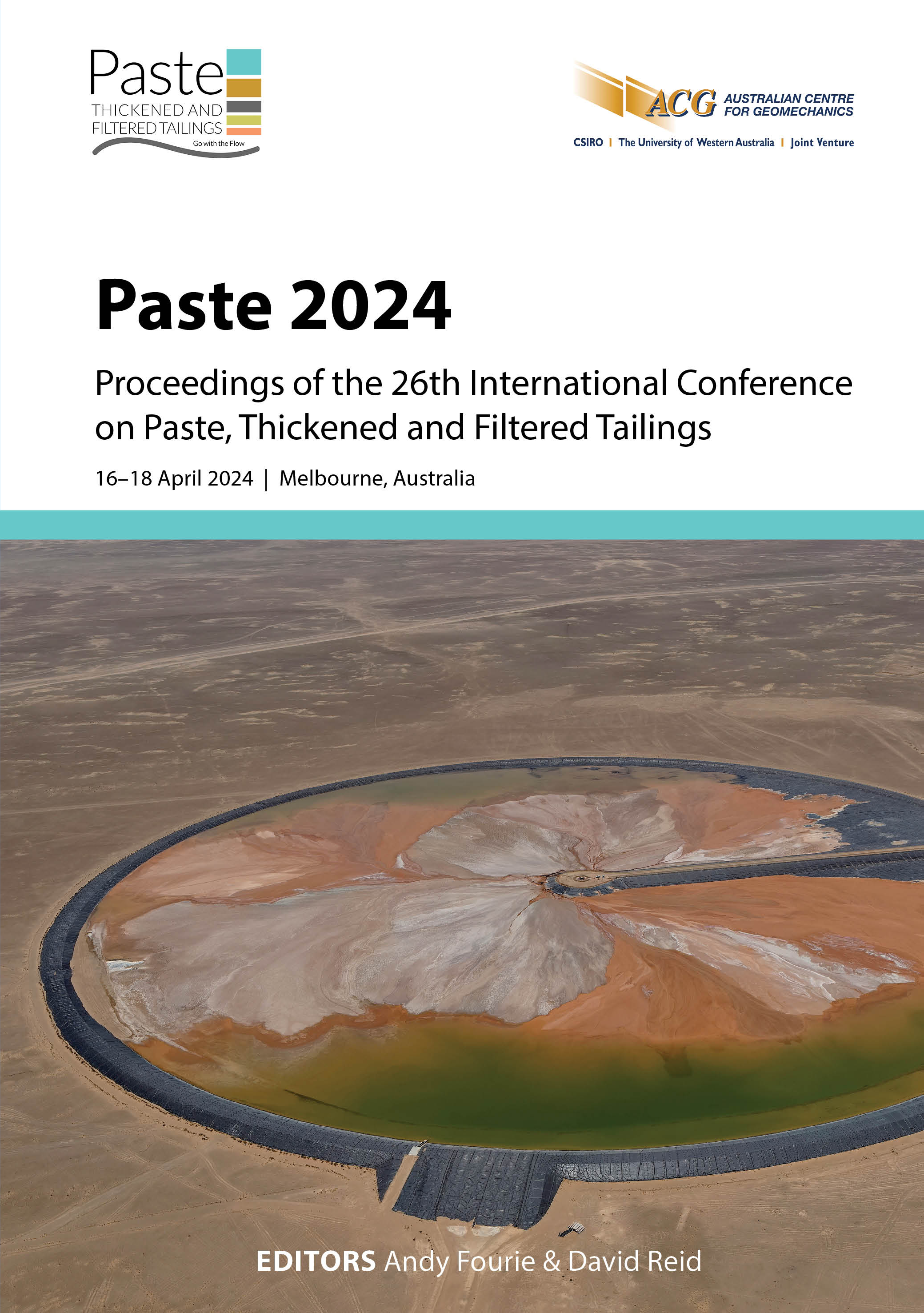Why accelerated mechanical consolidation delivers equal or greater benefits to other tailings management solutions

|
Authors: Santiago, O; Menezes, R; McAdam, W; Smirk, D |
DOI https://doi.org/10.36487/ACG_repo/2455_28
Cite As:
Santiago, O, Menezes, R, McAdam, W & Smirk, D 2024, 'Why accelerated mechanical consolidation delivers equal or greater benefits to other tailings management solutions', in AB Fourie & D Reid (eds), Paste 2024: Proceedings of the 26th International Conference on Paste, Thickened and Filtered Tailings, Australian Centre for Geomechanics, Perth, pp. 349-360, https://doi.org/10.36487/ACG_repo/2455_28
Abstract:
The International Council on Mining and Metals (ICMM) and members have created a roadmap that outlines significant improvements in the reduction and improvement of tailings management. Key aspects of tailings management under the ICMM improvement plan are to: Achieve safer management of tailings facilities Remove moisture from and strengthen tailings Reduce or eliminate the generation of tailings waste. All these improvement initiatives and additional benefits can be achieved by the implementation of in situ tailings management methodology termed accelerated mechanical consolidation (AMC™) on new and existing facilities. Australia-based company, Phibion, has been successfully deploying and implementing in situ mechanical dewatering (AMC) with a customised advanced Archimedes screw tractor, MudMaster®, which works oversaturated material to overcome hindered settling and consolidation, expediting the transition from slurry to solid. The process is primarily delivered through enhancing the particle packing density through repeated passes of the MudMaster (mechanical aid) to influence drainage and consolidation. The physical properties of the tailings and when combined with sequenced tailings deposition and ploughing of a predetermined layer thickness accelerates the dewatering rate and increases the final density that can be achieved which is not significantly impacted by rainfall nor dependent on evaporation. When executed with purposebuilt machines, consolidation is delivered orders of magnitude faster than self-weight processes and is highly predictable. In situ mechanical dewatering operations, utilising mechanical aid, are currently the preferred and best available technology used by a range of mining/processing operations including commodities such as copper, rare earth metals, nickel, zinc, bauxite and alumina among others. This paper provides a deep understanding on how in situ mechanical dewatering has provided equal or greater benefits and added value when compared with other tailings management solutions (i.e. thickening, filter press and dry stacking) to a zinc refinery and smelter tailings in Brazil. In situ mechanical dewatering applied with a specialised tractor has demonstrated a methodology for this operation to prolong the life of the refinery complex by extending the tailings storage facility’s (TSF) storage capacity, improving tailings dewatering, reducing water accumulation, aligning customer with ICMM objectives for tailings management and allowing for earlier than expected TSF closure, thus reducing liabilities and uncertainties in the process.
Keywords: in situ mechanical dewatering, accelerated mechanical consolidation, zinc, tailings management solution
References:
Cacciuttolo, C, Caldwell, J, Barrera, S & Vargas, W 2014, ‘Filtered dry stacked tailings: developments and new trends’, Proceedings of the 2nd International Seminar on Tailings Management, Gecamin, Santiago, pp. 357–370.
Cacciuttolo Vargas, C & Marinovic Pulido, A 2022, ‘Sustainable management of thickened tailings in Chile and Peru: a review of practical experience and socio-environmental acceptance’, Sustainability 2022, vol. 14, no. 17,
Chaedir, B, Kurnia, JC, Sasmito, AP & Mujumdar, A 2021, ‘Advances in dewatering and drying in mineral processing’, Drying Technology, vol. 39, no. 11, pp. 1–18,
International Alumina Institute 2014, Bauxite Residue Management Best Practice.
International Aluminum Institute 2016, Bauxite Residue Management Best Practice.
International Aluminum Institute 2022, Sustainable Bauxite Residue Management Guide.
International Council on Mining and Metals 2021a, Conformance Protocols: Global Industry Standard on Tailings Management.
International Council on Mining and Metals 2021b, Tailings Management: Good Practice Guide.
International Council on Mining and Metals 2021c, Tailings Management: Brief.
International Council on Mining and Metals 2022, Mining with Principles: Tailings Reduction Roadmap.
McPhail, G, Ugaz, R & Garcia, F 2019, ‘Practical tailings slurry dewatering and tailings management strategies for small and medium mines’, in AJC Paterson, AB Fourie & D Reid (eds), Paste 2019: Proceedings of the 22nd International Conference on Paste, Thickened and Filtered Tailings, Australian Center for Geomechanics, Perth, pp. 235–243,
McPhail, GI, DiDonna, P & Ugaz, R 2021, ‘Dam break analysis for BRDA 5 at Worsley Alumina Refinery’, in AB Fourie & D Reid (eds), Paste 2021: Proceedings of the 24th International Conference on Paste, Thickened and Filtered Tailings, Australian Centre for Geomechanics, Perth, pp. 177–200,
Munro, LD & Smirk, DD 2012, ‘Optimising bauxite residue deliquoring and consolidation’, Proceedings of the 9th International Alumina Quality Workshop, AQW Inc, Perth.
Munro, LD & Smirk, DD 2018, ‘How thick is thick enough?’, in RJ Jewell & AB Fourie (eds), Paste 2018: Proceedings of the 21st International Seminar on Paste and Thickened Tailings, Australian Centre for Geomechanics, Perth, pp. 23–34,
Smirk, DD & Jackson, S 2010, ‘In situ foundation improvement for upstream raising of embankments using dried tailings’, in R Jewell & AB Fourie (eds), Mine Waste 2010: Proceedings of the First International Seminar on the Reduction of Risk in the Management of Tailings and Mine Waste, Australian Centre for Geomechanics, Perth, pp. 251–260,
Smirk, DD, Santiago, O, Pardon, H 2022, 7th Congreso Relaves Peru 2022: Operacion, Ingenieria y Seguridade en la Gestion de Relaves.
South32 2023, GISTM Requirement 15.1 Public Disclosure Worsley Alumina.
Williams, DJ 2014, ‘Improved tailings management - how to achieve optimal water recovery and tailings density, and facilitate closure’, in J Wates (ed.), Proceedings of the 5th International Mining and Industrial Waste Management Conference.
© Copyright 2025, Australian Centre for Geomechanics (ACG), The University of Western Australia. All rights reserved.
View copyright/legal information
Please direct any queries or error reports to repository-acg@uwa.edu.au
View copyright/legal information
Please direct any queries or error reports to repository-acg@uwa.edu.au
